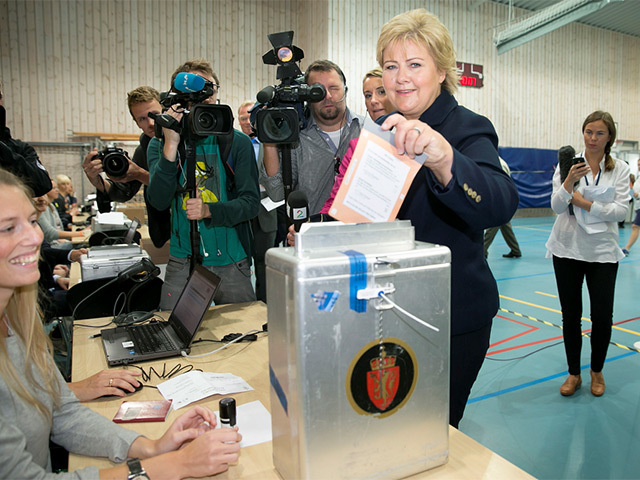
Norway’s Conservatives face tough negotiations to unite the opposition after ousting the Labor-led coalition on promises to cut taxes and loosen the state’s hold on Scandinavia’s richest economy.
Conservative leader Erna Solberg must now look to form a coalition among her opposition partners, who are split on how much of the country’s vast oil wealth to spend.
The Conservatives, the Progress Party, the Liberal Party and the Christian Democrats, got 96 seats of the 169 in parliament, according to a 93 percent count of the vote. Labor Prime Minister Jens Stoltenberg’s three-party coalition won 72 seats. Labor prevailed as the biggest party with 55 seats, while the Conservatives jumped to 48 seats, the count showed.
“They have some huge challenges in terms of agreeing on policy,” said Johannes Bergh, an election researcher at the Institute for Social Research in Oslo. “The desire for a new government is really strong on the center-right side so you might see people changing policy positions and really making an effort to agree and to have a new government.”
The Conservatives, which won on pledges to cut income and wealth taxes, boost investments in infrastructure and ease mortgage lending regulations, will enter government as the country hits an economic slowdown. The party has said it will look into restructuring the nation’s $750 billion wealth fund.
Once a haven from Europe’s debt turmoil, the $500 billion economy is now struggling to spur demand just as the rest of Europe surfaces from half a decade of economic pain. While growth will still outpace Europe, DNB ASA, Norway’s largest bank, predicts the country will be the only European nation of the 15 it tracks whose expansion won’t accelerate next year.
Norway’s mainland economy, which excludes oil and gas output, will grow 2 percent next year, unchanged from this year. That will beat the 0.7 percent estimate for the euro area, according to DNB forecasts.
Among the big changes that could come are a sell-off billions of dollars in state-owned Statoil. During the campaign Solberg said the government would cut its stake in the oil giant to 51%, from its current 67% stake in the company.
“It’s not unlikely that the government will cut its Statoil stake, though it probably isn’t imminent since these processes take time,” said analyst Andre Baustad Benonisen of Danske Bank Markets
“Potential buyers include everything from individuals to local and global funds.”
Danske estimates Statoil will rise 13 percent to 151 kroner over the next year. The stock was down 0.9 percent to 133.9 kroner as of 12:57 pm in Oslo, and has fallen 4 percent this year.
Opening up Lofoten to oil and gas exploration is set to be another contentious issue. The Conservatives and Progress Parties are in favour of allowing drilling off the region, but the Liberals have strongly opposed exploration around the archipelago because of potential damage to fishing and the ecology.
Solberg said last night that it will take some days before government talks can start.
Progress Party leader Siv Jensen, who has called for spending more of the nation’s oil wealth, said she will be tough yet realistic in the coming talks. The election means the party may join the government for the first time since it was formed as an anti-tax movement in 1973. The party has been an outlier in Norway in part for its anti-immigration views.
“For the first time in the Progress Party’s history we shall now sit down and negotiate a government platform,” Jensen said at an election-night rally. “We have said throughout the entire election campaign that it’s important for us to set a real mark on that platform.”
The power shift ends eight years with Stoltenberg at the helm of the Labor-led government. The 54-year-old steered Norway through the financial crisis and the 2011 terrorist attacks by right-wing extremist Anders Behring Breivik.
The Conservatives won 48 seats, up from 30 in 2009, according to the projections. The Progress Party won 29 seats, down from 41. The Christian Democrats won 10 seats, compared with 10 and the Liberal Party got 9, versus 2 in the last general election.
Labor, which will set the framework for the Conservatives’ first year in power, had proposed spending 3.3 percent of the oil fund to plug budget deficits, staying within the 4 percent rule for a fourth year. Still, with the fund quadrupling in size since the middle of the previous decade, even sticking to the 4 percent rule results in faster spending growth. The government estimates the fund will grow 50 percent by 2020.
Conservative finance spokesman Jan Tore Sanner said yesterday in an interview that the party won’t imperil the nation’s financial stability.
“We will have a responsible economic policy, we will stick to the fiscal rule,” he said. “We will manage very well.”
Recommended for you
